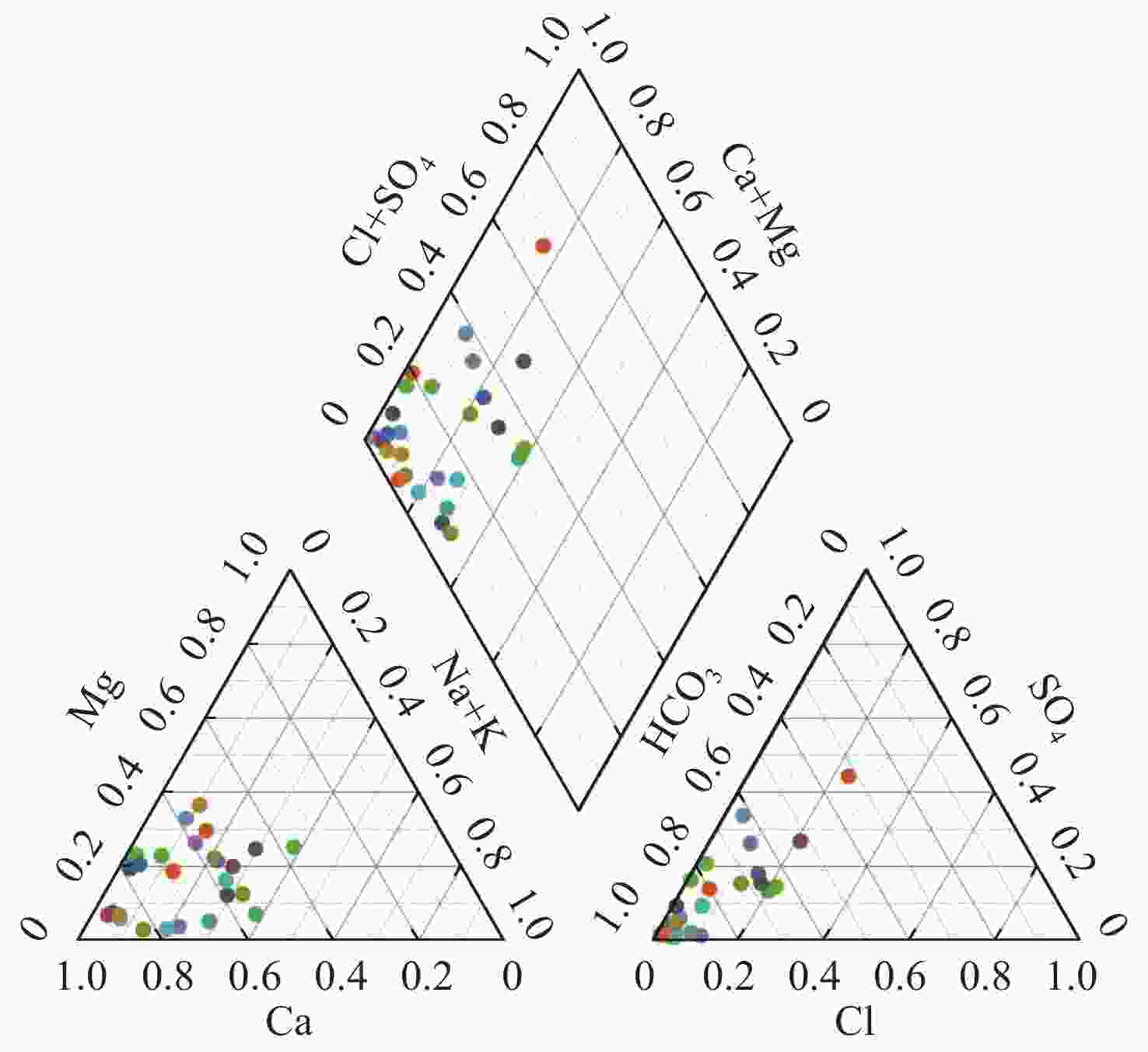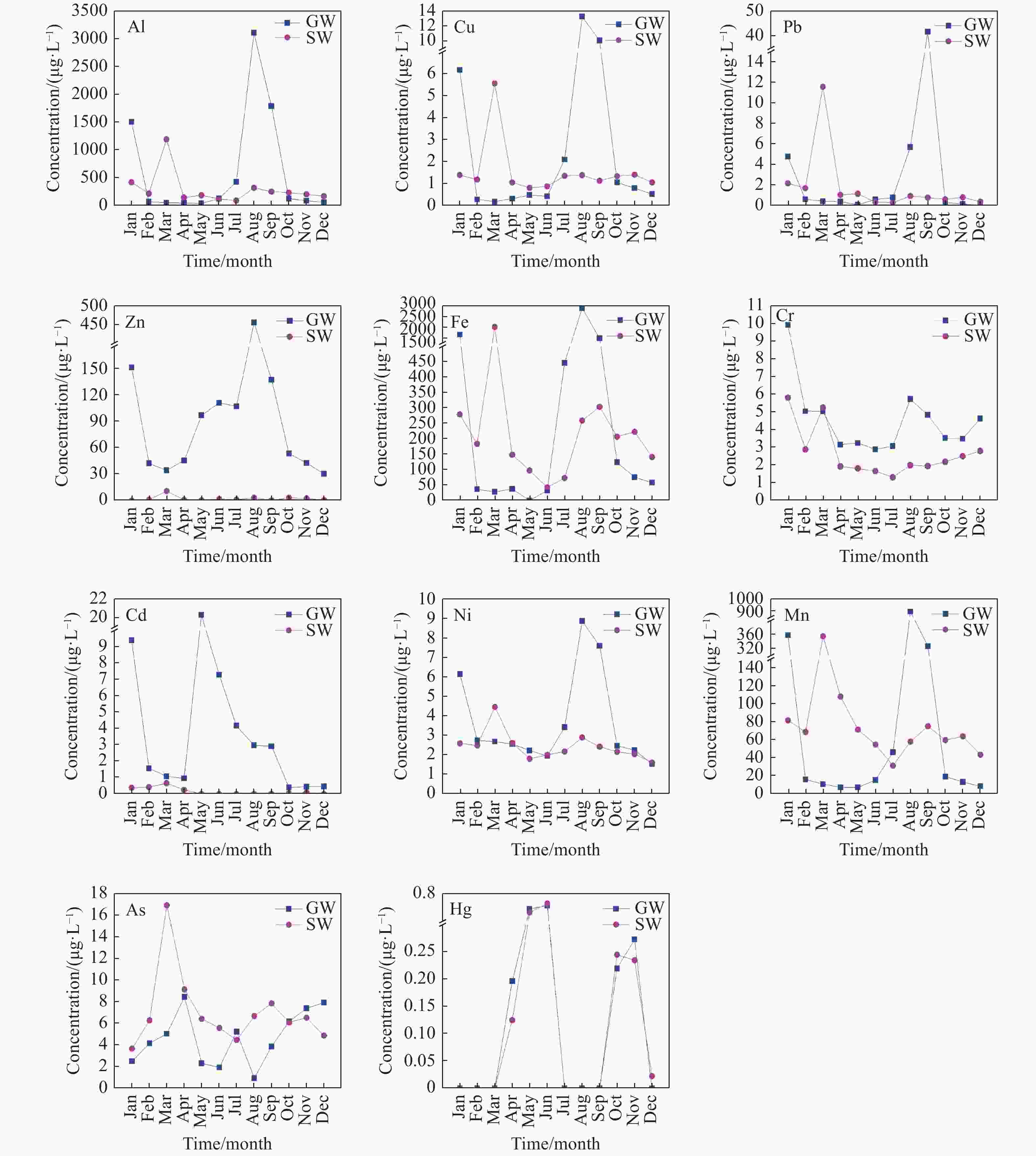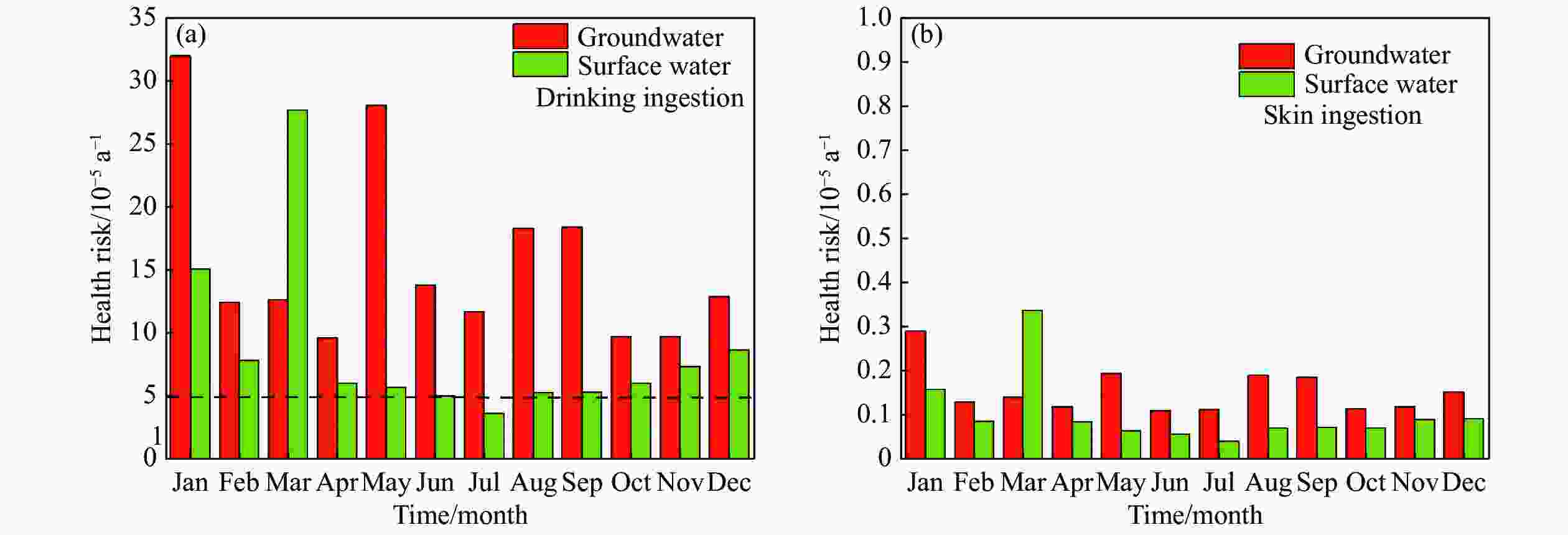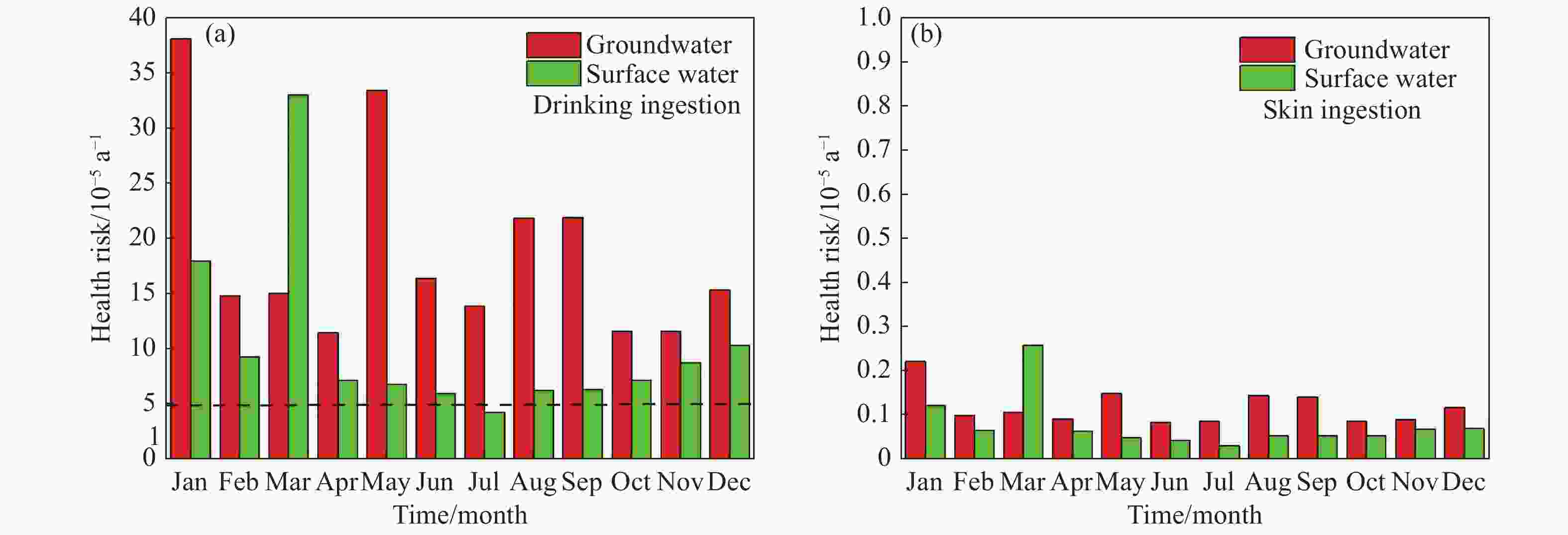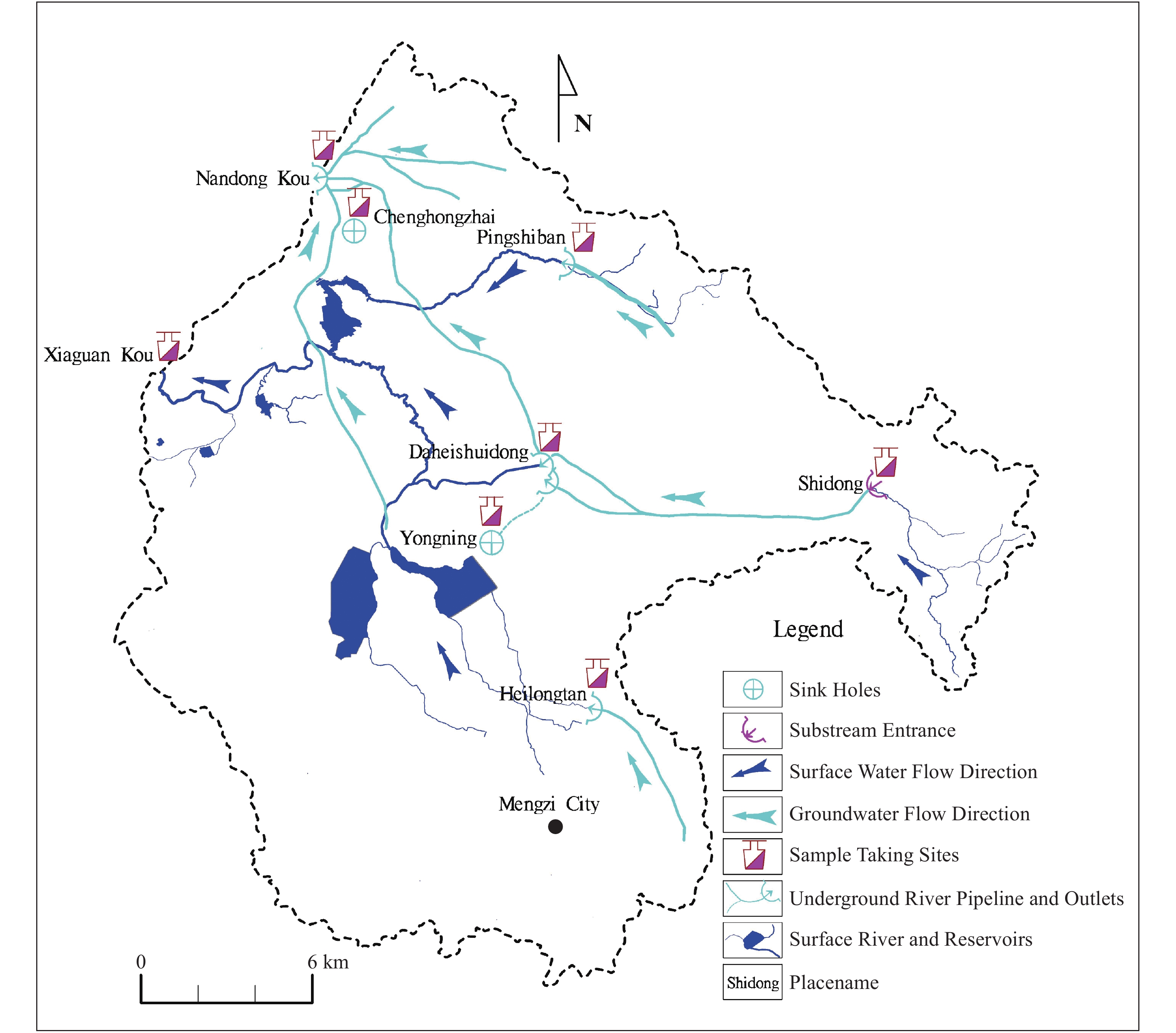Health risk assessment of heavy metal pollution in groundwater of a karst basin, SW China
-
Abstract: To investigate the presence of metal elements and assess their health risk for the populace in the Nandong Underground River Basin (NURB), we conducted an analysis of eleven common heavy metals in the water body. A Health risk assessment (HRA) model was employed to analyze 84 water samples from the NURB. The detection results revealed the following order of heavy metals concentrations: Fe > Al > Mn > Zn > As > Cd > Pb > Cr > Ni > Cu > Hg. Correlation analysis indicated a certain similarity in material source and migration transformation among these eleven metal elements. Our study identified that the health risks for local residents exposed to metal elements in the water of NURB primarily stem from carcinogenic risk (10−6–10−4 a−1) through the drinking water pathway. Moreover, the health risk of heavy metal exposure for children through drinking water was notably higher than for adults. The maximum health risks of Cr in both underground and surface water exceeded the recommendation standard (5.0×10−5 a−1) from ICRP, surpassing the values recommended by the Swedish Environmental Protection Agency, the Dutch Ministry of Construction and Environment and the British Royal Society (5.0×10−6 a−1). The results of the health risk assessment indicate that Cr in the water of NURB is the primary source of carcinogenic risk for local residents, followed by Cd and As. Consequently, it is imperative to control these three carcinogenic metals when the water was used as drinking water resource.
-
Table 1. Values of parameters related to health risk assessment
Metal PC
(10−3/cm·h−1)SF/(kg·d)·mg−1 RfD/mg·(kg·d)−1 Drinking water Skin penetration Drinking water Skin penetration Carcinogenic As 1.8 1.5 3.66 / / Cr 2 41 41 / / Cd 1 6.1 6.1 / / Non-carcinogenic Al 10 / / 0.14 0.14 Cu 0.6 / / 0.04 0.012 Pb 0.004 / / 0.0014 0.00042 Zn 0.6 / / 0.3 0.01 Fe 0.1 / / 0.3 0.045 Ni 0.1 / / 0.02 0.0054 Mn 0.1 / / 0.046 0.0018 Hg 1.8 / / 0.0003 0.0003 Note: *No reference standard value; PC, permeability coefficient; SF, slope factor; RfD, reference daily intake. Table 2. Concentrations of metals in the water of Nandong Groundwater River Basin (μg·L−1)
Metals n=84 Scope Average Standard deviation Variation coefficient Exceed standard limitation (%) Al 9.90–5,274.00 440.04 913.09 2.08 38.10 Cu nd–26.70 2.34 4.75 2.03 0 Pb nd–124.00 3.62 15.43 4.26 2.38 Zn nd–1,311.00 82.39 211.24 2.56 1.19 Fe nd–7,790.00 486.83 1,127.61 2.32 26.19 Cr 1.10–10.70 3.47 2.08 0.60 0 Cd nd–61.00 3.63 10.34 2.85 7.14 Ni 0.78–13.90 2.99 2.22 0.74 0 Mn 2.44–2,035.00 113.13 276.85 2.45 15.48 As nd–54.70 6.13 8.01 1.31 17.86 Hg nd–0.94 0.41 0.26 0.63 40.48 Metals n=84 China US EPA WHO Drinking water (Limits) Surface water(Ⅲ) Ground water(Ⅲ) Drinking water Drinking water Al 200 – 200 – 200 Cu 1,000 1,000 1,000 1,300 2,000 Pb 10 50 10 15 10 Zn 1,000 1,000 1,000 – – Fe 300 – 300 – 300 Cr 50 50 50 100 50 Cd 5 5 5 5 3 Ni 20 – 20 – 70 Mn 100 100 100 – 400 As 10 50 10 10 10 Hg 1 0.1 1 *nd means not detected, –means no corresponding reference value. Table 3. Pearson correlation matrix for metal elements and pH in the water samples
n=84 EC pH Al Cu Pb Zn Fe Cr Cd Ni Mn As Hg EC 1.000 0.164 −0.042 0.083 0.031 0.177 −0.064 0.033 0.124 0.140 0.023 0.163 0.060 pH 1.000 0.045 0.040 0.134 −0.022 0.032 0.179 −0.070 0.109 0.024 −0.041 −0.147 Al 1.000 0.746** 0.579** 0.240* 0.929** 0.632** 0.037 0.916** 0.652** 0.290** −0.201 Cu 1.000 0.756** 0.692** 0.700** 0.479** 0.171 0.805** 0.920** 0.282** −0.172 Pb 1.000 0.285** 0.490** 0.351** 0.112 0.690** 0.486** 0.268* −0.103 Zn 1.000 0.166 0.210 0.469** 0.327** 0.757** 0.060 0.016 Fe 1.000 0.641** 0.014 0.836** 0.659** 0.447** −0.207 Cr 1.000 0.199 0.643** 0.431** 0.169 −0.292** Cd 1.000 0.095 0.141 0.032 0.297** Ni 1.000 0.657** 0.206 −0.237* Mn 1.000 0.294** −0.154 As 1.000 −0.014 Hg 1.000 * Significant at 0.05 level.
* * Significant at 0.01 level.
EC means Electrical ConductivityTable 4. Annual per capita health risks caused by metals in different types of water though drinking water and skin penetration, respectively (a−1)
Exposure way Metals Groundwater Surface Water Adults Children Adults Children Drinking water Carcinogenesis As /–1.93×10−5 /–2.30×10−5 6.91×10−7–
4.30×10−58.24×10−7–
5.12×10−5Cr 5.11×10−5–
2.30×10−46.09×10−5–
2.74×10−42.36×10−5–
2.30×10−42.81×10−5–
2.74×10−4Cd /–1.95×10−4 /–2.32×10−4 /–4.67×10−6 /–5.56×10−6 No-carcinogenesis Al 4.53×10−11–
1.97×10−85.39×10−11–
2.35×10−83.70×10−11–
1.69×10−84.41×10−11–
2.01×10−8Cu /–3.50×10−10 /–4.16×10−10 2.23×10−12–
2.70×10−102.65×10−12–
3.21×10−10Pb /–4.64×10−8 /–5.53×10−8 /–1.64×10−8 /–1.95×10−8 Zn /–2.29×10−9 /–2.73×10−9 /–7.67×10−11 /–9.13×10−11 Fe /–8.31×10−9 /–9.90×10−9 /–1.36×10−8 /–1.62×10−8 Ni 3.85×10−11–
3.64×10−104.59×10−11–
4.34×10−102.04×10−11–
2.86×10−102.43×10−11–
3.40×10−10Mn 2.78×10−11–
2.31×10−83.31×10−11–
2.76×10−86.07×10−11–
1.44×10−87.23×10−11–
1.72×10−8Hg /–1.54×10−9 /–1.83×10−9 /–1.64×10−9 /–1.96×10−9 Drinking water Carcinogenesis As /–4.40×10−7 /–3.37×10−7 1.57×10−8–
9.78×10−71.21×10−8–
7.49×10−7Cr 5.30×10−7–
2.38×10−64.06×10−7–
1.83×10−62.45×10−7–
2.38×10−61.87×10−7–
1.83×10−6Cd /–1.01×10−6 /–7.74×10−7 /–2.42×10−8 /–1.85×10−8 No-carcinogenesis Al 2.35×10−12–
1.02×10−91.80×10−12–
7.83×10−101.92×10−12–
8.75×10−101.47×10−12–
6.71×10−10Cu /–3.62×10−12 /–2.78×10−12 2.31×10−14–
2.80×10−121.77×10−14–
2.14×10−12Pb /–3.21×10−12 /–2.46×10−12 /–1.13×10−12 /–8.68×10−13 Zn /–2.14×10−10 /–1.64×10−10 /–7.15×10−12 /–5.48×10−12 Fe /–2.87×10−11 /–2.19×10−11 /–4.70×10−11 /–3.59×10−11 Ni 7.39×10−14–
6.99×10−135.66×10−14–
5.35×10−133.92×10−14–
5.48×10−133.00×10−14–
4.20×10−13Mn 3.68×10−13–
3.07×10−102.82×10−13–
2.35×10−108.04×10−13–
1.91×10−106.16×10−13–
1.46×10−10Hg /–1.43×10−11 /–1.10−11 /–1.53×10−11 /–1.17×10−11 “/”means no calculation results. -
Adewoyin OO, Kayode OT, Omeje O, et al. 2019. Risk assessment of heavy metal and trace elements contamination in groundwater in some parts of Ogun state. Cogent Engineering, 6(1): 1632555. DOI: 10.1080/23311916.2019.1632555. Ameh EG. 2019. Geochemistry and multivariate statistical evaluation of major oxides, trace and rare earth elements in coal occurrences and deposits around Kogi east, Northern Anambra Basin, Nigeria. International Journal of Coal Science & Technology, 6(2): 260−273. DOI: 10.1007/s40789-019-0247-4. Anthony E, Emmanuel DS, Jamel S, et al. 2022. Hydrogeochemical characteristics, sources and human health risk assessment of heavy metal dispersion in the mine pit water–surface water–groundwater system in the largest manganese mine in Ghana. Environmental Technology & Innovation, 102312. Ba JJ, Gao FF, Peng C, et al. 2022. Characteristics of nitrate and heavy metals pollution in Huixian Wetland and its health risk assessment. Alexandria Engineering Journal, 61(11): 9031−9042. DOI: 10.1016/j.aej.2022.02.045. Bakyayita GK, Norrström AC, Kulabako RN. 2019. Assessment of levels, speciation, and toxicity of trace metal contaminants in selected shallow groundwater sources, surface runoff, wastewater, and surface water from designated streams in lake Victoria basin, Uganda. Journal of Environmental and Public Health, 6734017. Bilal B, Tatiana VC, Kirill AV, et al. 2021. The heavy metal pollution in groundwater, surface and spring water in phosphorite mining area of Tebessa (Aleria). Environmental nanotechnology, Monitoring & Management, 16: 1−10. DOI: 10.1016/j.ennm.2021.100591. Duan XL, Zhao XG. 2014. Highlights of the Chinese exposure factors handbook (Adult). China Science Press, Beijing. (in Chinese) Duan XL, Zhao XG. 2016. Highlights of the Chinese exposure factors handbook (Children). China Environmental Science Press, Beijing. (in Chinese) EPA. 2006. Risk-based Concentration Table, http://www.epa.gov/reg3hwmd/risk/human/rbc/rbc1006.pdf. General Administration of Quality Supervision, Inspection and Quarantine of the P. R. China. 2017. Standardization Administration of the P. R. China. GB/T 14848—2017 Standard for Groundwater Quality. (in Chinese) Jiang Y, Wu Y, Groves C, et al. 2009. Natural and anthropogenic factors affecting the groundwater quality in the Nandong karst underground river system in Yunan, China. Journal of Contaminant Hydrology, 109: 49−61. DOI: 10.1016/j.jconhyd.2009.08.001. Lan FN, Zhao Y, Jiang ZC, et al. 2022. Exploring long-term datasets of land use, economy, and demography variations in karst wetland areas to detect possible microclimate changes. Land Degradation & Development, 33: 2743−2756. DOI: 10.1002/ldr.4302. Li J, Zhao Y, Zou SZ, et al. 2021. Metal pollutions and human health risks on groundwater from wet, normal, and dry periods in Huixian karst wetland, China. Environmental Science, 42(1). (in Chinese) Li J, Zou SZ, Liang YP, et al. 2020a. Metal distributions and human health risk assessments on waters in Huixian Karst wetland, China. Environmental Science, 41(11): 4948−4957. (in Chinese) DOI: 10.13227/j.hjkx.202003212. Lin JH, Yan Y, Yang GH. 2020. Distribution characteristics of mercury in biofilm and sediment of a typical mercury contaminated river. Earth Environment, 48(3): 341−347. (in Chinese) DOI: 10.14050/j.cnki.1672-9250.2020.48.041. Liu P, Jiang ZC, Li YQ, et al. 2023. Quantitative study on improved budyko-based separation of climate and ecological restoration of runoff and sediment yield in Nandong underground river system. Water, 15: 1263. DOI: 10.3390/w15071263. Luo X, Ren B, Hursthouse AS, et al. 2019. Potentially toxic elements (PTEs) in crops, soil, and water near Xiangtan manganese mine, China: Potential risk to health in the foodchain. Environ. Geochem Health, 1–12. Mashaal N, Akagi T, Ishibashi. 2020. Hydrochemical and isotopic study of groundwater in Wadi El-Natrun, Western Desert, Egypt: Implication for salinization processes. Journal of African Earth Sciences, 172: 104011. DOI: 10.1016/j.jafrearsci.2020.104011. Ran JK. 2020. A field experimental study on ecological remediation of heavy metal contaminated farmLand soil in Gejiu city, Yunnan Province. M. S. thesis. Kunming, Kunming University of Science and Technology, (in Chinese) Sadeghi H, Fazlzadeh M, Zarei A, et al. 2020. Spatial distribution and contamination of heavy metals in surface water, groundwater and topsoil surrounding Moghan's tannery site in Ardabil, Iran, Int. International Journal of Environmental Analytical Chemistry, 102(5): 1049−1059. State Environmental Protection Administration of the P. R. China, GB 3838-2002 Standard for Surface Water Quality. (in Chinese) Susan, Tumwebaze B, Abrabam, et al. 2017. Water contamination with heavy metals and trace elements from Kilembe copper mine and tailing sites in Western Uganda; implications for domestic water quality. Chemosphere Environmental Toxicology & Risk, 169: 281−287. USEPA. 2013. Code of federal regulations, protection of environment, risk assessment guidance for superfund, Human Health Evolution Manual (Part A). https://www.govinfo.gov/content/pkg/CFR-2013-title40-vol30/pdf/CFR-2013-title40-vol30,Pdf.USEPA. USEPA, 1992. Guidelines for exposure assessment. Office of Health and Environmental Assessment US EPA, Washington DC: 186. Verma P, Singh PK, Sinha RR, et al. 2020. Assessment of groundwater quality status by using water quality index (WQI) and geographic information system (GIS) approaches: A case study of the Bokaro district, India. Applied Water Science, 10(1): 27. Yang SR, Huang QH, Huang QR, et al. 2023. Study on human heavy metal exposure in Gejiu tin mining area, Yunan. Yunnan Geology, 42(1): 106−113. (in Chinese) Yu Y, Zhu RP, Ma DM, et al. 2022. Multiple surface runoff and soil loss responses by sandstone morphologies to land-use and precipitation regimes changes in the Loess Plateau, China. Catena, 217: 106477. Zeng M, Guo R, Yang SM, et al. 2019. Heavy metal pollution and ecological risk assessment in agricultural production areas: Taking Gejiu City of Yunnan Province as an example. Soils and Crops, 8(1): 85−92. (in Chinese) DOI: 10.11689/j.issn.2095-2961.2019.01.010. Zhang Y, Guo CQ, Sun PA. 2019. Groundwater health risk assessment based on spatial analysis in the Qiaomaidi watershed. China Environmental Science, 39(11): 4762−4768. (in Chinese) DOI: 10.19674/j.cnki.issn1000-6923.2019.0555. Zhao Y, Li YQ, Qin XM, et al. 2017. Tracer tests on distribution and structural characteristics of karst channels in Nandong underground river drainage. Carsologica Sinica, 36(2): 226−233. (in Chinese) DOI: 10.11932/karst20170210. Zhou JM, Jiang ZC, Xu GL, et al. 2019. Distribution and health risk assessment of metals in groundwater around iron mine. China Environmental Science, 39(5): 1934−1944. (in Chinese) DOI: 10.19674/j.cnki.issn1000-6923.2019.0230. Zhou QM, Jiang ZC, Xu GL, et al. 2019. Water quality analysis and health risk assessment for groundwater at Xiangshui, Chongzuo. Environmental Science, 40(6): 2675−2685. (in Chinese) DOI: 10.13227/j.hjkx.201810234. -

 E-mail alert
E-mail alert Rss
Rss



 下载:
下载:
